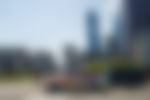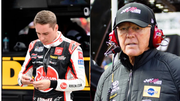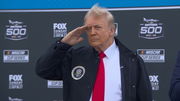
USA Today via Reuters
Jul 2, 2023; Chicago, Illinois, USA; A general view as cars race along Grant Park during the Grant Park 220 of the Chicago Street Race viewed from the NEMA Chicago buliding. Mandatory Credit: Jon Durr-USA TODAY Sports

USA Today via Reuters
Jul 2, 2023; Chicago, Illinois, USA; A general view as cars race along Grant Park during the Grant Park 220 of the Chicago Street Race viewed from the NEMA Chicago buliding. Mandatory Credit: Jon Durr-USA TODAY Sports
On July 6–7, NASCAR will make its second annual return, winding through the streets of Chicago for the 2024 Grant Park 165. The infamous Street Race helped Windy City create an estimated 109 million-dollar economic impact last year. The City Council on Global Affairs even reported that the race helped generate 750 jobs when the world’s premier stock car racing experience rolled into town. So why have Chicagoans not been too receptive to the event’s cumulative “impact”?
From complaints against the seemingly “overpriced” tickets to grievances about the muffled-out V8s making too much or too little noise to almighty Mother Nature itself, the 2023 Chicago Street Race was anything but predictable. But the logistical hurdles of prime-time racing action are back in Illinois for the second straight week, only this time the circuit throws a curveball for those unfamiliar with its one-of-a-kind layout.
However, one of the biggest problems in Chicago has always been its traffic. And with impending restrictions on the thoroughfare awaiting its residents, courtesy of Grant Park 165, many question why not take it all back to a real racing facility instead of making rounds in the city. Something like the Chicagoland Speedway?
ADVERTISEMENT
Article continues below this ad
Should NASCAR ditch the streets and return to Chicagoland?
The Second City and NASCAR have a history that dates back to 1954 when the first sanctioned Grand National race took place at the now-lost Santa Fe Speedway, 20 miles southwest in Willow Springs. Since then, the sport’s governing body has run events at four different racetracks in Chicago. A few races were held during the late ‘50s in the Chicago Bears’ home ground, Soldier Field, followed by a couple of Truck Series outings in the now-demolished 1.029-mile Chicago Motor Speedway during the early 2000s.
The only two venues currently in existence (barring the Bears’ stadium) are Chicagoland Speedway and the temporary Grant Park 165 street circuit, with Chicagoland being primarily brought into existence specially to test an untapped NASCAR market, back in the ‘90s. From 2001 to 2019, the 1.52-mile Joliet racetrack was a mainstay of the NASCAR schedule, birthing many incredible moments. Alex Bowman was the last driver to win at Chicagoland on June 30, 2019. Post-COVID, NASCAR abandoned the racetrack, leaving it to turn into another relic of the past.
An official statement by NASCAR from a few years ago read, “We genuinely appreciate the support and enthusiasm of our fans in the Chicagoland region. While we currently do not have details on a timeline or specific series, we do plan to bring NASCAR racing back to Chicagoland Speedway at some point in the future.”

Instead, three years later, fans were treated to an all-new street race format cutting through the heart of Chicago in a never-before-seen manner. The Grant Park 220 (soon-to-be-shortened 171) made its debut in 2023 with a brand new ‘international’ winner from the world of Australian V8 Supercars, Trackhouse Racing’s Shane van Gisbergen.
And with it came various woes from the residents of Chicago to the admirers of Chicagoland. But the biggest problem in its inaugural edition last year was undoubtedly the widespread amount of criticism of the race’s negative impact on the transit and commutation situations inside the city. Although the 2023 Grant Park 171 managed to pull in a recorded 47,505 attendees, many observe that is roughly the same number as the Chicagoland Speedway’s projected capacity on race day.
All of it comes with the necessary parking arrangements and the obvious trademark mile-and-a-half asphalt tri-oval. Hence, one could say that NASCAR racing’s return to Chicagoland would largely negate the traffic situation because the racetrack has dedicated facilities. Regardless, the city of Chicago recently made public its road closure information leading up to the race weekend on July 6th–7th and beyond, and the good news is that the closures will be shorter than last year, down from 25 days to only 19.
The bad news is it will still bring about a slew of street closures in downtown Chicago. Starting Monday, June 10th, the chaos begins with closures on Ida B. Wells Drive between Michigan and Jackson Drive. Late night, on the 19th & 20th, expect temporary lane closures, especially on Michigan Ave. From June 27th onwards things get serious as Columbus, Jackson, and Balbo start shutting down, with Lake Shore Drive following suit on July 1st. By July 4th, there will be total gridlock around Roosevelt and Michigan.

The Grant Park 165 weekend will see the most extensive shutdown. Roads near Grant Park or along the 2.2-mile race track will all remain blocked until July 8th, with most major roads reopening by the end of that day. Some streets will have to await reopening until July 18th, eleven days after the checkered flag drops. Nevertheless, statements from the city assure Chicagoans that they’ll be keeping DuSable Lake Shore Drive, Michigan Avenue, and Columbus Drive as priorities for reopening.
Fortunately, the Dan Ryan, Kennedy, Eisenhower, and Stevenson expressways will all stay open on July 6th and 7th. Also, local streets like State, Dearborn, Clark, Wells, Franklin, and LaSalle will act as a respite for commuters in the Loop district. DuSable Lake Shore Drive will remain open northbound from South Shore Drive to the I-55 merge and southbound from Hollywood to Randolph.
But when these developments reached the ears of those dwelling out and about the confines of the upcoming Second City speed festival, the reactions were exactly what one could expect from its understandable concerned citizens.
Trending
Fans divided over oval vs. street circuit
Jeff Gluck of The Athletic recently reshared an update from the WGN Morning News on X (also known as Twitter) of an image of the start-finish line normally located on South Columbus Drive.
Fans expressed their opinions strongly with this one complaining about the near-three-week-long closure through a deafening sentence: “Never had to shut down any roads when they raced at Chicagoland.” Another wrote, “Here’s hoping it’s the last time,” while others were even harsher to remember, “I forgot we were doing this cr*p again.”
Setup for the Chicago Street Race, which is one month from tomorrow, set to begin: https://t.co/sybxamwywa
— Jeff Gluck (@jeff_gluck) June 6, 2024
ADVERTISEMENT
Article continues below this ad
An interesting comment emerged amidst the sea of comments on Gluck’s post as a passionate diehard suggested, “Chicagoland would’ve been better. Nothing against half ass street courses but they need to run them in cities with no racetrack within 125 miles of it. Would make sense instead of ignoring the fact chicagoland is a much better and permanent facility.”
Many felt like NASCAR should “Go back to @roadamerica“ among other suggestions like the also-defunct Kentucky Speedway. But as this fan rightfully opined, “Although I wasn’t the biggest fan of this race when it was announced. You can’t argue that last year’s race wasn’t great. Watching SVG show off so cool. I’m actually looking forward to this year’s race weekend.”
ADVERTISEMENT
Article continues below this ad
Just like that, four weekends before the actual event, and only a few days before the Sonoma road race, the NASCAR nation awaits the discussions to unfold into the eventual excitement of the Chicago Street Race.
While navigating the city will be a headache, there will still be plenty to do in Grant Park during the closures. The Chicago Park District promises to keep more than half the park accessible, with minimal restrictions. NASCAR will even throw a free festival in Butler Field during the race weekend, for fans to soak up the race atmosphere without a ticket. Other spots like Maggie Daley Park, the Cancer Survivor’s Garden, and the Museum Campus will also be open throughout.
ADVERTISEMENT
ADVERTISEMENT
ADVERTISEMENT
ADVERTISEMENT






